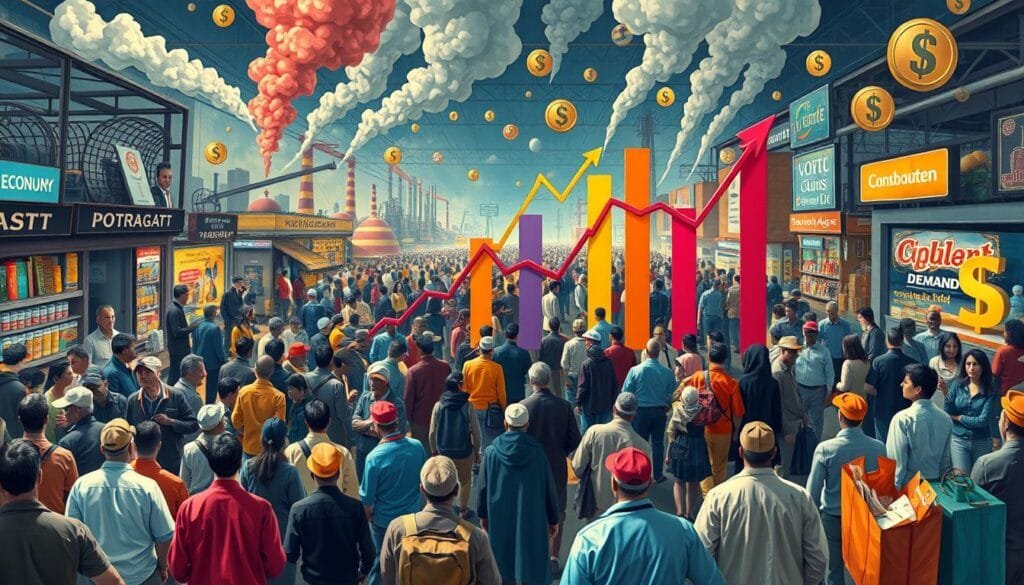Have you ever seen people rush to buy strawberries in season, then stop when prices go up? This shows us how demand works in economics, a key idea in understanding markets. But what’s really behind the link between price and demand?
Demand isn’t just about how many goods are sold. It involves complex consumer behavior and market dynamics. We’ll explore the demand curve and how people’s choices affect market demand. Plus, we’ll see how big economic forces influence overall demand.
We’ll also look at some special cases, like Veblen and Giffen goods. These are exceptions that defy usual economic thinking. Knowing about these can help businesses make smart choices that meet what customers want.
Now, let’s get into the deep connections that define demand in economics.
Key Takeaways
- The law of demand shows that price and demand move in opposite directions.
- Demand elasticity is about how demand changes with price shifts.
- Many factors like price, income, and tastes affect demand.
- Economic policies like changing interest rates also affect the total demand.
- Special products like Veblen and Giffen goods break the usual rules of demand.
Introduction to Demand in Economics
Understanding demand basics is key in economics to figure out the consumer market. The demand curve shows how price and demand are linked. It usually goes down, showing people buy more at lower prices. At high prices, folks buy less.
Look at organic pears in the market. The perfect balance is selling 150,000 pears at $1.20 each. This balance, or equilibrium, comes when supply meets demand perfectly.
Shifts in demand can happen for many reasons, like changes in what consumers want or expect. A move to the right means more demand, higher prices, and more sales. A shift to the left means less demand, lower prices, and fewer sales. For example, fewer people could mean less demand for organic pears. This would lower both the price and amount sold.
| Shift Type | Price | Quantity |
|---|---|---|
| Demand shifts outward | Rises | Rises |
| Demand shifts inward | Falls | Falls |
| Supply shifts inward | Rises | Falls |
| Supply shifts outward | Falls | Rises |
Knowing these economic principles helps us understand the market better. We can make smarter choices. Businesses and policy-makers can also see how changes affect the market. This helps use resources more efficiently.
The Law of Demand
The law of demand is a key idea in economic theory. It explains how price affects how much people want to buy. This rule helps us understand market actions and make economic policies. Let’s explore what it means and why it matters, with a look at the demand curve.
Definition and Importance
The law of demand shows that price and demand move in opposite directions. When prices go up, people want less; when they drop, people want more. For example, a big cut in wheat production can make prices soar by 500%, showing how price changes affect demand.
For governments and policymakers, knowing about the law of demand is crucial. It guides them in setting policies to adjust demand in the economy. Changing mortgage rates, for instance, affects house buying. Higher rates mean fewer buyers; lower rates mean more. This shows how important the law of demand is in making economic choices.
Demand Curve
The demand curve is a graphic way to show the price-quantity relationship. It usually goes downward, showing how price and demand move in opposite ways. Let’s take a closer look at its shapes and what they mean.

Most demand curves bend inwards, but some are straight lines in textbooks. They can shift for many reasons, like changes in buyer numbers or incomes. An interesting point is some goods, like luxury items, might see more demand when they get pricier. This happens because people see them as status symbols.
| Good Type | Demand Curve Shape | Price Impact |
|---|---|---|
| Normal Good | Downward Sloping | Inverse |
| Giffen Good | Upward Sloping | Direct |
| Veblen Good | Upward Sloping | Direct |
In the end, the demand graph is vital for seeing how price changes affect what people buy. By looking at different curves, we get why people buy more or less of something. This helps us get the complex ways people act and how it shapes economic theory.
Factors Affecting Demand
Demand is shaped by many factors, each reflecting complex economic and personal interactions. It’s vital for businesses and policymakers to grasp these elements. This understanding helps them predict market trends and meet consumer needs.
Price of Goods and Services
The price of goods and services greatly impacts demand. The Law of Demand explains how price and demand are inversely related. As prices go up, demand usually goes down. We see this when consumers change their buying habits due to price hikes. For example, if a product’s price rises by 5%, demand might drop by 2.5%.
Consumer Preferences
Consumer preferences significantly shape demand. These preferences can be influenced by endorsements or trends. When a celebrity backs a product, demand might jump as fans try to imitate their favorite stars. Future product expectations, like waiting for the latest gadgets, also steer buying choices. Such factors demonstrate the power of external influences on the market.
Income of Buyers
The link between consumer income and demand is crucial. For normal goods, as income goes up, so does demand. The opposite is true for inferior goods—higher income decreases their demand. This shows how earning power affects buying habits. Economic conditions, like recessions, also play a role; people tend to cut back on luxury items and focus on necessities.
These dynamics are noticeable in various scenarios, like spending changes during the COVID-19 pandemic or seasonal demand boosts near schools. Recognizing these demand influencers allows businesses to adapt their strategies. They can align what they offer with changing consumer expectations and market trends.
What’s Demand in Economics: Market vs Aggregate Demand
Understanding market demand and aggregate demand is key in economics from a macroeconomic perspective. These concepts show the total market demand but differ in scope and details. Let’s explore how they compare.

Market demand combines all consumer desires for a product or service at different prices. The market demand curve decreases as prices go up, showing the income and substitution effects. It plots demand price against quantity demanded.
Aggregate demand, however, covers total spending on domestic goods and services in an economy. It factors in consumer consumption, investments, government expenses, and net exports. Unlike market demand, the aggregate demand curve’s downward slope stems from various effects like the real-balance, interest-rate, and net-export effects. It compares the general price level against the economy’s real GDP.
The aggregate supply mirrors a nation’s GDP, showing all production and sales. As prices rise, aggregate demand usually drops, showing an essential macroeconomic relationship. It indicates how higher prices can lower consumer buying power and reduce overall consumption.
Price levels and interest rates are closely linked. Rising interest rates can slow down capital investments. This detail helps understand why the aggregate demand curve slopes downward. Viewed through a macroeconomic perspective, analyzing both market and aggregate demand curves offers insights into the economy’s function. This analysis highlights the various effects on different economic levels.
Determinants of Demand
Understanding determinants of demand is key in economics. It helps us see why folks buy things. Factors like substitute goods and what people expect to happen next hugely impact this.

Substitute Goods
Having options, like tea or coffee, changes demand. If tea gets pricey, more might buy coffee. This shows why knowing market trends is important.
Substitute goods’ prices changing can shift demand a lot. For example, when houses got more expensive in the mid-2000s, fewer people bought them.
Consumer Expectations
What people think will happen economically affects their buying. If folks feel good about their future money, they spend more now. But if they’re worried, they might hold back.
Future price thoughts also matter. Expecting higher prices soon can make people buy more now. But if they think prices will drop, they might wait.
Substitute goods and what consumers expect shape the market a lot. These elements show the tricky play between prices, buying choices, and options. They help us guess where things might head.
Elasticity of Demand
The idea behind elasticity of demand is how price or income changes impact how much of a product people want. It helps us see how sensitive demand is to price changes, how income affects demand, and the effect on customer behavior when prices of related products change.
Price Elasticity
Price elasticity looks at how much the wanted amount of a product changes when its price does. It’s key for knowing how prices affect demand. If demand changes a lot with a slight price change, we call this elastic demand (elasticity coefficient > 1). For example, if dropping a product’s price from $10 to $8 makes sales rise from 30 to 50 units, we’ve got an elasticity coefficient of 2.25, showing elastic demand.
If the demand doesn’t change much despite price moves, that’s inelastic demand.
Income and Cross Elasticity
Income elasticity looks at how changes in people’s incomes change demand. Items with positive income elasticity get more popular as people earn more. Cross elasticity checks how demand for one product reacts to price changes in another, highlighting the impact of price changes in similar products. For instance, a drop in poultry prices can make people buy more chicken and less beef and pork.
Close substitutes often have higher elasticity. But essentials like gasoline have inelastic demand. They’re always needed, despite few alternatives.
Grasping demand elasticity is vital for businesses to set the right prices, earn more, and predict how customers react to price changes. Knowing these ideas helps make smart choices in all market situations.
Conclusion
This analysis has explored the many sides of demand in economics. It shows how important it is for understanding markets and making economic choices. We looked at what demand means and why the law of demand matters. We also discussed how different types of demand help us see the big picture in both small and big economic trends.
Many things can change demand, like prices, what people prefer, and how much money they have. For example, if prices drop by 10%, people might buy 20% more. This shows how prices strongly affect what people decide to buy. Also, whether people are buying things they need or just want makes a difference in how prices can be set.
It’s key to know what causes demand to change. This includes looking at other options, what buyers expect, and how these factors change market balance. Studies on how sensitive demand is for luxury items show it’s higher than for basic needs. This helps businesses and leaders guess how changes can shift demand. In short, understanding demand deeply helps us get why consumers act the way they do, see market trends, and plan smart strategies that fit with economic rules.
FAQ
What is economic demand?
Economic demand is when people want to buy a certain amount of goods or services. They are ready to buy them at different prices over a time.
How does consumer behavior influence market dynamics?
What people prefer and buy changes the market. This changes demand, affecting prices and what’s available.
What are the basic principles of demand in economics?
Demand’s basics include how price influences how much people want. As prices go up, people want less. This is shown by the demand curve.
What is the law of demand?
The law of demand tells us, with everything else steady, when a good’s price drops, people want more. And if the price goes up, they want less.
What is a demand curve?
A demand curve shows how the price of something and how much people want it relate. It goes down to the right, showing price and demand are opposite.
What factors can affect economic demand?
Many things affect demand, like product prices, what people like, and their income. Any change here can move the demand curve.
How do consumer preferences impact demand?
What people like impacts demand. If they start liking something more, its demand goes up. This moves the demand curve right.
What is the income effect?
The income effect shows how changes in people’s income affect how much they buy. This can happen because of price changes.
What is the difference between market demand and aggregate demand?
Market demand is the total demand in a specific market. Aggregate demand is all demands in an economy at different prices.
What are substitute goods?
Substitute goods can replace each other. When one gets pricier, people might buy its cheaper substitute instead.
How do consumer expectations affect demand?
If people think prices will go down or up, it changes what they buy now. They might wait or buy quickly.
What is price elasticity of demand?
It shows how demand changes with price changes. High elasticity means people react a lot to price changes.
What is cross elasticity of demand?
It’s about how demand for one good reacts to price changes in another good. Positive for substitutes, negative for complements.
